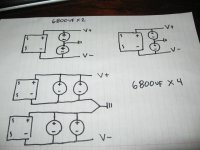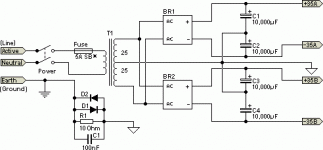I have a dilemma, I am not sure if I am willing to sacrifice capacitance for voltage separation. if I use the one on top, I will get 3.400uf per rail only, but I will get separation in voltage.
if I use the one on bottom I will get more capacitance 13.600uf, but I will have to share voltage for both channels.😕
PS: Transformer does not have center tap, just dual secondaries.
if I use the one on bottom I will get more capacitance 13.600uf, but I will have to share voltage for both channels.😕
PS: Transformer does not have center tap, just dual secondaries.
Attachments
Last edited:
The need for capacistance depends on the application and power.
If its a 2x100-150w 8r amplifier, it would probably benefit more from 10+kuF than channel separation.
How about connecting the two channels in opposite phase?
If its a 2x100-150w 8r amplifier, it would probably benefit more from 10+kuF than channel separation.
How about connecting the two channels in opposite phase?
How do you figure 3400 uF per rail, for the top ones? It would give 3400 uF BETWEEN the rails, but 6800 uF from each rail to Gnd. No?
Why not just add four caps to the top ones and be done?
Also, for even better separation, if you can afford it, and have the space, use a whole separate transformer for each channel.
By the way: For both cases, to get the best separation, you would want to be sure to run the two channels' ground conductors separately, from the PSU to each channel's electronics, and only have them connect with each other at the star ground point (probably a short PCB trace stub where all of the grounds connect, which is then connected to the main smoothing caps' ground). If the ground-return currents shared any length of conductor, each channel would induce voltages that could modulate the other channel's ground voltages, at the non-PSU ends of all of the ground-return conductors that were connected "upstream", which could get summed in with the input signal, et al. It's the same reason that star grounding is used. But I figured I'd re-iterate it, since you are concerned about channel separation.
Why not just add four caps to the top ones and be done?
Also, for even better separation, if you can afford it, and have the space, use a whole separate transformer for each channel.
By the way: For both cases, to get the best separation, you would want to be sure to run the two channels' ground conductors separately, from the PSU to each channel's electronics, and only have them connect with each other at the star ground point (probably a short PCB trace stub where all of the grounds connect, which is then connected to the main smoothing caps' ground). If the ground-return currents shared any length of conductor, each channel would induce voltages that could modulate the other channel's ground voltages, at the non-PSU ends of all of the ground-return conductors that were connected "upstream", which could get summed in with the input signal, et al. It's the same reason that star grounding is used. But I figured I'd re-iterate it, since you are concerned about channel separation.
Last edited:
You simply don't have a choice, you must use lower schematic. Using upper one you will blown your amp in a few seconds. 

Yes, given two secondaries (no CT) only the lower one will work. To do the top one you need a CT.
Connecting the correct two leads of the secondaries together will effectively produce a centre tap and the transformer can be used with either configuration. A single bridge is a little more voltage efficient but the two bridge solution makes for a quieter ground by reduces the current (reservoir charging pulses) in the ground line.
Thank you guys! My toroidal transformer is 300vac 32vac X 2. it does not have a center tap.it is from old Adcom amplifier that I savaged for parts. I guess I will have to stick to the one on the bottom. I wanted to do it this way but this transformer has a Center Tap and mine does not!!!!🙁
Attachments
2 secondaries connected in series (correct polarity of course) will produce a single secondary with a center tap. 2 secondaries gives you more options.😉
2 secondaries connected in series (correct polarity of course) will produce a single secondary with a center tap. 2 secondaries gives you more options.😉
Correct. Dual identical secondaries gives you more options than a plain centertap, not fewer.
If you join the secondaries in the center, then it IS a centertap.
Last edited:
- Status
- Not open for further replies.
- Home
- Amplifiers
- Solid State
- Dual secondaries transformer.

